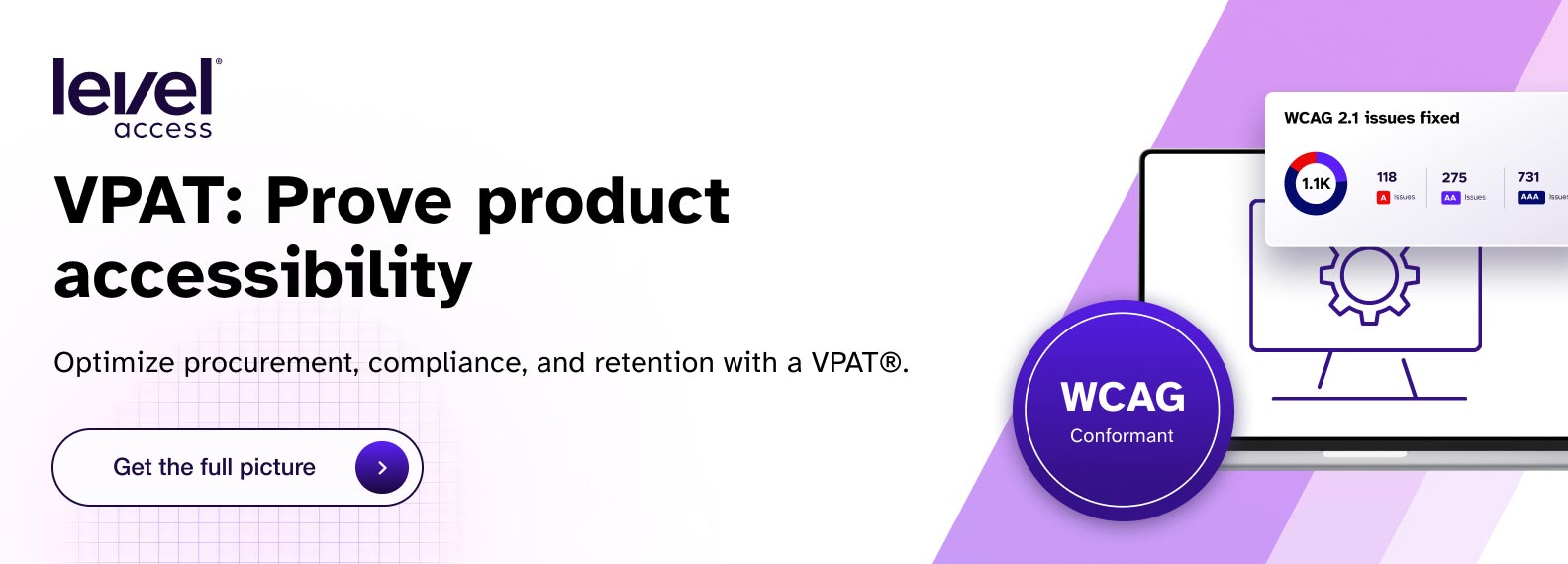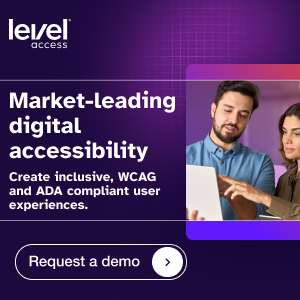WCAG 101: Understanding the Web Content Accessibility Guidelines
The Web Content Accessibility Guidelines (WCAG), developed by the World Wide Web Consortium, are technical standards that help make the digital world accessible to people with disabilities. Numerous stakeholders, including disability advocacy groups, government agencies, and accessibility research organizations, collaborated to create these guidelines, which are considered the universal standard for digital accessibility.
Importantly, WCAG isn’t a law—but organizations that want to comply with the Americans with Disabilities Act (ADA) should follow WCAG standards. WCAG includes many success criteria that developers and designers can apply to remove barriers to access for people with disabilities in digital environments.
Below are several examples of web accessibility best practices recommended by WCAG:
- Ensure form-entry functions have either no time limit or an extended time limit for those who need more time.
- Provide consistent elements, including navigation features, headers, footers, and sidebars, across all web pages. This consistent approach helps ensure end users can easily find these elements on any webpage.
- Make your website navigable without using a mouse—the keyboard “tab” button, alone, should enable end users to navigate any page on your website.
- Provide a proper, clearly identifiable content level structure for screen reader users.
- Use proper contrast ratios between foreground text and background colors for those with vision-related disabilities.
- Avoid design elements that may induce seizures. For example, no website element should flash more than three times in a one-second interval.
- Help users prevent and fix their mistakes. For example, provide text descriptions of all automatically detected errors.
What is POUR and why is it critical to WCAG standards?
WCAG standards are rooted in four main principles: perceivable, operable, understandable, and robust, often called POUR.
- Perceivable: Information must be perceivable to people using only one of their senses, so they understand all related content.
- Operable: End users must be able to interact with all webpage elements. For instance, your website should be easily navigable with just a keyboard or voice controls for non-mouse users.
- Understandable: The principle is just what it seems—end users must be able to understand web page content and functionality information.
- Robust: Your website must effectively communicate information to all users, including users of assistive technologies, and remain compatible with evolving technologies and user needs.
WCAG Versions 1.0, 2.0, 2.1 and 2.2
The W3C regularly updates WCAG guidelines, as digital accessibility continually evolves with improved technology and more sophisticated design practices.
- WCAG 1.0 was released in May 1999, comprising 14 guidelines and the A, AA, and AAA conformance level hierarchy.
- Published in 2008, WCAG 2.0 introduced POUR and redefined the A, AA, and AAA conformance levels.
- WCAG 2.1 was published in 2018 to provide interim updated standards reflecting advancements in digital content after WCAG 2.0. WCAG 2.1 covers considerations for the accessibility of mobile devices and tablets not addressed in WCAG 2.0. Overall, WCAG 2.1 introduced 17 additional success criteria.
- WCAG 2.2 added nine new success criteria, many of which relate to barriers for users with visual, mobility, hearing, and cognitive disabilities.

WCAG Conformance Levels and Related Compliance Requirements
WCAG guidelines offer specific information on making websites and other digital experiences more accessible. But understanding and conforming to the WCAG standards is also critical for any organization that wants to mitigate legal risks. Let’s unpack the different conformance levels with WCAG and explore some of the laws and regulations referencing these guidelines.
The Three Levels of WCAG Conformance: A, AA, and AAA
There are three levels of conformance with WCAG guidelines:
- A = the minimum level requirements any website should be able to meet.
Requirements include:
- Keyboard-only content access
- Clearly labeled forms with instructions so users know what the forms require
- Content compatibility with assistive technologies
- Providing clear information or instructions in additional ways to using just shape, size, or color
- AA = the mid-range conformance level that represents strong accessibility. It satisfies all Level A and Level AA criteria.
Requirements include:- Text and background must have the proper color contrast (a minimum of 4.5 to 1)
- Content organization must have a clear heading structure and follow a logical order (e.g., H1, H2, H3)
- Navigation elements must be consistent throughout every webpage
- AAA = the highest level of conformance, providing exceptional accessibility, but unachievable for certain content. It satisfies A, AA, and 28 additional criteria.
Requirements include:
- A minimum of 7 to 1 contrast ratio for text and backgrounds
- Sign language translation for pre-recorded video content
- Expanded audio descriptions for pre-recorded video content
WCAG Conformance and Legal Compliance
Even though WCAG itself isn’t a law, it’s widely recognized as the web accessibility benchmark for legislation and court decisions. For example, Section 508 of the Rehabilitation Act of 1973 requires that federal agencies make their electronic and information technology conform with WCAG 2.0 AA standards. Similarly, the Accessibility for Ontarians with Disabilities Act (AODA) mandates that public websites and web content published after January 2, 2012, conform to WCAG 2.0 AA.
Additionally, the Unruh Civil Rights Act and California Assembly Bill 434 (AB424) require the websites of California state entities to align with WCAG 2.1 Level AA Standards and Section 508 requirements. WCAG is also part of EN 301 549, the harmonized European information and communication technology standard and benchmark for European Accessibility Act (EAA) compliance.
While Title III of the Americans with Disabilities Act (ADA) doesn’t explicitly mention website accessibility, the U.S. Department of Justice (DOJ) has referenced WCAG in its private enforcement of the law. Additionally, Title II of the ADA now requires that the websites of state and local governments conform with WCAG 2.1 level AA standards.
Evaluating Accessibility Based on WCAG Success Criteria
Many free web accessibility tools can help determine if your web content conforms to WCAG standards. One example is the WAVE tool. Simply type in your URL, and you’re given a summary of errors on that page. Another is the IBM Equal Access Accessibility Checker, which enables you to complete page-level testing on Chrome and Firefox browsers.
However, it’s essential to understand that these tools rely solely on automation, which cannot detect every error. Human testing is necessary to assess your digital assets’ usability and accessibility comprehensively.man testing is necessary for a truly comprehensive assessment of your digital assets’ usability and accessibility.
Related Posts
Digital Accessibility Myths & Facts
Check out these "myths and facts" to get a better understanding of WCAG techniques, the limitations of automated scanning tools, and the role of assistive...
Web Accessibility Training Videos and Webinars
This collection of PowerPoint presentations, webinars and captioned videos contains a broad range of vetted, digital accessibility resources. Developers, designers and content authors will all...
WCAG Quick Tips for Content Writers
Writing in plain language, effective use of alt text, and providing clear instructions are among the many important responsibilities of content writers as they work...
